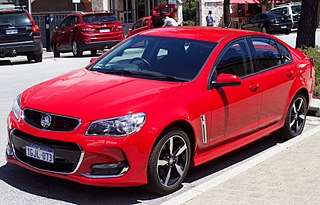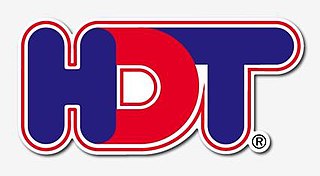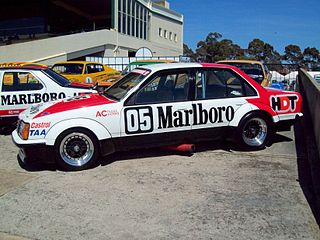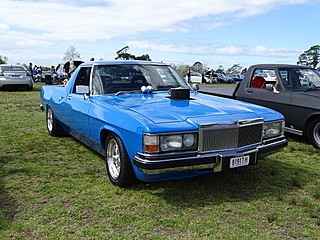
The Holden Commodore is a full-size car that was sold by Holden from 1978 to 2020. It was manufactured from 1978 to 2017 in Australia and from 1979 to 1990 in New Zealand, with production of the locally manufactured versions in Australia ending on 20 October 2017.

The Holden Monaro is a rear-wheel drive coupé manufactured by General Motors Holden in Australia from 1968 to 1975 and later reintroduced from 2001 to 2005. It was also manufactured as a 4-door sedan from 1973 to 1977.

The Holden Torana is a mid-sized car that was manufactured by Holden from 1967 to 1980. The name apparently comes from an word meaning "to fly" in an unconfirmed Aboriginal Australian language. The original HB series Torana was released in 1967 and was a four-cylinder compact vehicle closely based on the British Vauxhall Viva HB series of 1966 - 1970.

The Holden Camira is a mid-size car that was produced by Holden between 1982 and 1989. It was Holden's version of GM's J-body family of cars—GM's third "global" car platform. The name "Camira" comes from an Aboriginal word meaning "wind."

The Opel Monza is an executive fastback coupe produced by the German automaker Opel from 1977 to 1986. It was marketed in the United Kingdom as the Vauxhall Royale Coupé by Vauxhall.

The Holden Kingswood is a full-size car that was manufactured in Australia by GM Holden, from the beginning of the HK series in 1968 through to the conclusion of the WB series in 1984. Prior to 1968, the full-size Holden range of family cars comprised the Holden Standard, the Holden Special, and Holden Premier models. Initially, the HK range of models included the basic Holden Belmont, the Kingswood, and the luxury-oriented Holden Premier, all of which were manufactured in a choice of sedan and station wagon bodies. Commercial variants were offered in three types: coupé utility, panel van, and later from 1971, a heavy-duty Holden One Tonner cab chassis. The utility (ute) version was originally marketed in both Belmont and Kingswood configurations. However, after the Belmont name was deleted from commercials at the end of HQ in late 1974, the base model commercials were sold only with the "Holden" badge.

The Holden Gemini is a compact car that was produced by Holden and sold in Australasia from 1975 to 1986. It was based on the Japanese Isuzu Gemini, one of the many models based on the GM T-car platform.

The Holden Dealer Team (HDT) was Holden's semi-official racing team from 1969 until 1986, primarily contesting Australian Touring Car events but also rallying, rallycross and Sports Sedan races during the 1970s. From 1980 the Holden Dealer Team, by then under the ownership of Peter Brock, diversified into producing modified road-going Commodores and other Holden cars for selected dealers via HDT Special Vehicles.

The Holden Commodore (VB) is a mid-size car that was produced by Holden, from 1978 to 1980. It was the first iteration of the first generation of the Holden Commodore.

The Holden Commodore (VH) is a mid-size car that was produced by Holden from 1981 to 1984. It was the third iteration of the first generation of the Holden Commodore.

The Holden Commodore (VN) is a full-size car that was produced by Holden from 1988 to 1991. It was the first iteration of the second generation of this Australian made model, which was previously a mid-size car, as well as the first Commodore available as a coupé utility. The new range included the luxury variants, Holden Berlina (VN) and Holden Calais (VN) and, from 1990, introduced the commercial Holden Utility (VG).

The Holden Commodore (VL) is a mid-size car that was produced by Holden from 1986 to 1988. It was the final iteration of the first generation of the Holden Commodore and included the luxury variant, Holden Calais (VL). Between February 1986 and August 1988, 151,801 VL model Commodores were built.

The Holden Commodore (VK) is a mid-size car that was produced by Holden from 1984 to 1986. It was the fourth iteration of the first generation of the Holden Commodore and introduced the luxury variant, Holden Calais (VK) sedan.

Statesman is an automotive marque created in 1971 by the Australian General Motors subsidiary, Holden. Statesman vehicles were sold through Holden dealerships, and were initially based on the mainstream Holden HQ station wagon platform, thereby providing more interior room and generally more luxurious features than their Holden-branded sedan siblings. Production ceased with the last of the WB series cars in December 1984.
The Holden straight-six motor is a series of straight-six engine that were produced by General Motors Holden at their Port Melbourne plant between 1948 and 1986. The initial Grey motor was so dubbed because of the colour of the cylinder block, later motors came in the form of a Red, Blue, Black, and the four-cylinder Starfire engine. These engines were fitted to all Australian designed Holdens of the same years, and the four-cylinder Starfire notably also found its way into the Toyota Corona (XT130). The Grey motor is a different engine from the others, while the Red, Blue, Black, and even the Starfire are all inter-related with many common parts and castings.

The Holden V8 engine is an overhead valve (OHV) V8 engine that was produced by the Australian General Motors subsidiary, Holden (GMH), between 1969 and 2000.

The 1980 Australian Touring Car Championship was an Australian motor racing competition for Group C Touring Cars. Authorised by the Confederation of Australian Motor Sport as a National Title, it was the 21st Australian Touring Car Championship.

Holden HZ is a full-sized automobile which was produced in Australia between October 1977 and April 1980 by Holden in a variety of equipment levels and in several different body styles. It was also assembled in New Zealand.

The Holden WB series is an automobile which was produced by Holden in Australia from 1980 to 1984. It is a facelifted version of the Holden HZ series, which it replaced. Unlike the HZ and every other full size Holden series before it, the Holden WB was only offered in commercial vehicle bodystyles with no sedan or wagon passenger car variants. The long-wheelbase WB series models were marketed under the separate Statesman marque, absent of all Holden branding.























